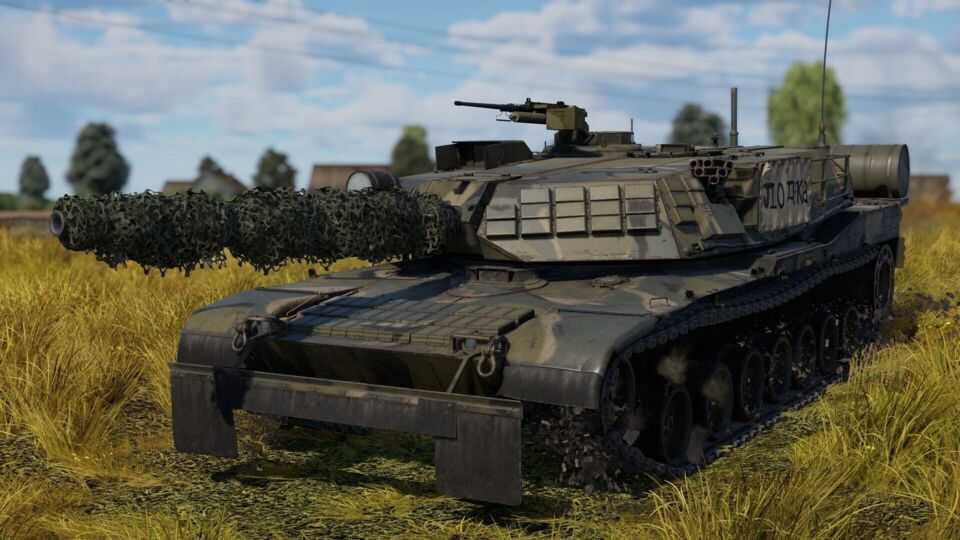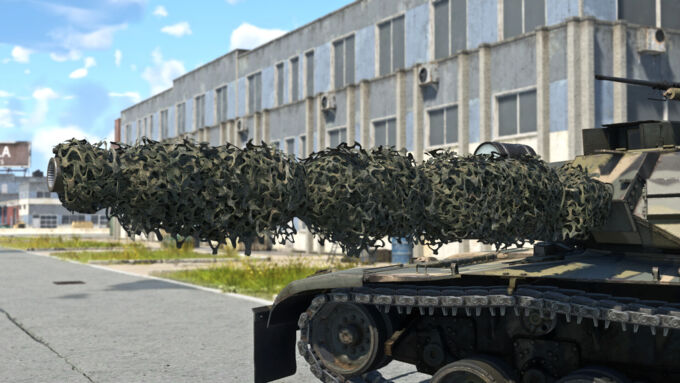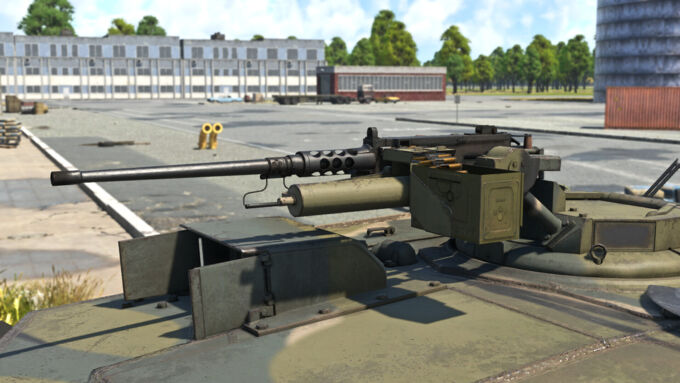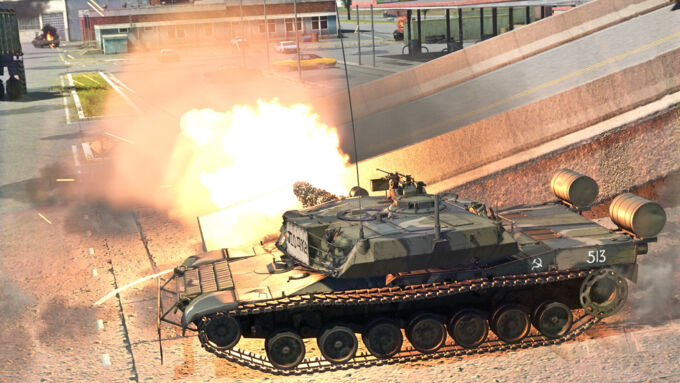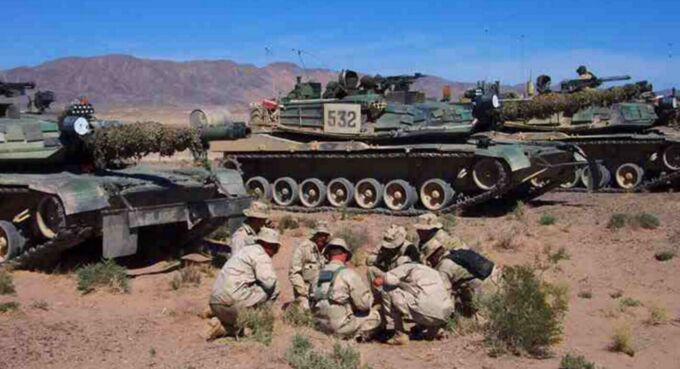The M1 KVT mirrors the M1 Abrams in all of its combat capabilities. It is truly one of the best MBTs of its rank, thanks to its rather heavily armoured turret, excellent mobility and high rate of fire, which together allow the player to set the rules of engagement and not be dependent on certain maps or other conditions. In addition to the visual differences from the original, the M1 KVT also has premium bonuses that speed up the research of the US ground tree.
| Pros | Cons |
| Excellent mobility and speed | It is almost impossible to shoot backwards |
| Decent survivability | Weak hull side protection |
| High targeting speed | Big size |
| Good hull and turret protection | Weak zone between the turret and the hull |
| High fire rate |
Survivability and armour
The M1 KVT has good frontal protection against various types of ammunition due to its NERA armor — resistance to HEAT projectiles is equivalent to 900 mm thickness, and protection against kinetic ammunition is up to 480 mm. This is enough to withstand a frontal hit from many rounds (DM23, M833, Shot L23) without significant damage, but Soviet and Chinese APFSDS (3BM42, 125-I) can easily penetrate the armor. The situation with HEAT rounds is much better, although one should be wary of tandem rounds with an armor penetration of more than 800 mm, often found on Soviet BMP-2M, Khrizantema-S or Chinese AFT09.
The hull sides are partially covered with 70mm composite side skirts in the front part, while the hull side itself has a thickness of 30mm conventional armor steel, which makes it very vulnerable even to autocannons, especially closer to the rear of the hull. With the Vismod kit installed, the tank has no side skirts at all! The turret sides are somewhat better protected, mainly by NERA elements, which increase their resistance to kinetic projectiles up to 180 mm and HEAT up to 300 mm.
Like any tank, the M1 Abrams' armor has vulnerable areas that have been sustained from the earliest modifications to the most recent. The large turret ring is the most common target for the enemy, as the armor in this area is only 50 mm thick. Also worth mentioning is the gun mask, which is large enough to be easily hit, but this problem is inherent in almost every western tank.
Looking at the tank's armor, you might think that it is extremely vulnerable to most enemies and easy to destroy, but this is not the case. The tank was designed with a focus on the survivability of the crew in combat, for which many technical solutions were adopted: large internal compartment, additional armored bulkheads between the fuel tanks and the engine, and the location of the shells behind the armor plate with blowout panels. Thanks to these solutions, the Abrams is the best tank in terms of survivability in combat. Fuel tanks often "consume" both kinetic and shaped charge ammunition, and the large internal compartment minimizes damage to the crew and modules, allowing the tank to be repaired and the crew to continue the fight. Also note the blowout panels - they might give a tank a second chance in combat. A projectile that hits the armor but does not penetrate the armor plate will not detonate the projectiles inside, but will trigger the blowout panels, resulting in a fireshow.
To increase the survivability, it is a good idea to take no more than 44 rounds in combat (although anyone would hardly need even as many). It will put all of them behind a blowout panel in the turret. A full ammo load will mean having some of them without any protection at all.
Mobility
Thanks to the 1520 hp Honeywell AGT1500 gas turbine engine, the M1 is extremely mobile, and the KVT fully replicates the characteristics of the standard version of the M1 Abrams: the 56-ton tank can easily reach speeds of up to 72 km/h, and thanks to the wide tracks, this speed can be achieved on any surface. In addition, it can move quickly both forward and backward, developing a reverse speed of up to 40 km/h.
This is enough for a quick change of position or move fast repair or resupply. Compared to its main competitors such as the Leopard 2A4, T-80B and Vickers Mk.7, the M1 KVT surpasses them in mobility and top speed, not only forward, but also in reverse.
Armaments
Main armament
The M1 KVT is armed with the M68A1 105mm cannon, which has long been standard on NATO tanks. The cannon has excellent ballistics and a fast reload time of 5 seconds (with "Aced" crew), which makes it possible to fire at several enemies at once or have a chance for a second shot. Vertical aiming angles range from -10° down to 20° up. The gun has a horizontal aiming speed of 40°/sec, which allows for quick aiming or turning the turret to face the threat. The vehicle is also equipped with a 1st generation thermal imaging sight and a laser rangefinder, which allows for quick detection of the enemy tank and precise firing at any distance. It should be noted that due to the engine bay the tank cannot fire directly at its rear.
M1 KVT can employ the following ammunition:
- M456A2 — HEATFS. This round is hardly effective due to the widespread NERA or Dynamic protection of the enemies. It can still be useful against lightly-armoured targets;
- М735 — APFSDS with 350 mm penetration at 100 meters. While it is possible to use it against any target, M1 KVT has M774 from the beginning, and 774 should be used;
- M774 — APFSDS with a good penetration of 370 mm at 100 meters and good stabilization if hit at angles up to 78°. The projectile is enough to destroy any target, although more protected ones would still be penetrated only in weak spots. M774 is recommended to be used as a main round;
- М393А2 — HESH round with 127 mm penetration at all distances and angles. It can be used against light tanks or AA;
- М416 — smoke shell. Can create a smoke that will last up to 25 seconds and will cover a tank against the enemy.
Overall, the tank can carry up to 55 rounds, only 44 of which are protected by blowout panels. First stage ammo stowage has 22 rounds, but due to fast reload it is better to take around 30 shells.
Machine guns
The M1 KVT tank is equipped with two machine guns: the 12.7mm M2HB and the 7.62mm M240. The high-caliber M2HB is mounted on the roof of the tank and has an elevation angle of up to +65°. The 7.62mm M240 machine gun is paired with the main gun. The anti-aircraft machine gun is well suited for engaging low-flying helicopters and destroying lightly armored targets. The paired 7.62mm is best suited for marking the enemy on the battlefield, shooting down ATGMs, or destroying small obstacles that block the view (bushes, fences, trees, etc.).
Usage in battles
Thanks to the combination of all its features, the M1 KVT effective both in active, aggressive play and in positional, defensive combat. In general, the tank's capabilities in different game modes (arcade, realistic/sim) do not differ significantly — the vehicle allows you to use almost any combat tactics in any game mode.
Excellent mobility facilitates active gameplay, allowing you to be in the right place at the right time or to retreat in time to change positions, and the 105 mm cannon's quick reload will allow you to outgun any enemy. In urban maps, the best solution is to get to a position where you can see the enemy's usual path to the capture point as quickly as possible, allowing you to take the enemy by surprise. Most enemies can be destroyed with the first shot, but if you fail, no problem, you can always quickly roll back behind cover and be ready for another shot in ~5 seconds.
In a positional and defensive play, all hope rests on the spacious layout of modules and crew inside the tank, as well as a good protection of the turret, which sometimes allows you to survive more than a dozen hits of enemy shells on the tank, but it is best to use the terrain and various covers to hide the silhouette of the tank, making it difficult for the enemy to target vulnerable areas. The thermal sight and rapid-fire cannon allow you to fire at enemy vehicles from a distance. It should be noted, however, that this style of play may not always be effective, as the view is limited to a certain direction, and the enemy might just avoid it.
Also, remember that the M1 KVT cannot fire at the rear due to the design of the engine compartment, so any tank coming from that direction can easily destroy you without getting in danger.
History
The U.S. Army has a special OPFOR (Opposing Force) unit that specializes in simulating potential enemy equipment during exercises. As practice shows, there is indeed a need for this, because friendly fire losses have always occurred, and often the scale of this phenomenon is truly tragic. And no matter how much the military may study the external features of this or that vehicle from the screens of monitors, in battle it is always possible to make a mistake.
The OPFOR base is Fort Irwin, which has real T-72s, but at the same time they also use fake vehicles that only remotely resemble the original, the so-called "vismods". One of such modifications is the M1 VISMOD "Krasnovian" tank, which plays the role of the Soviet T-72 tank, the photo of which the Americans received from the parade in the GDR. The USA also uses other armored vehicles of its own production to imitate Soviet tanks, BMPs and BMDs. Among such vehicles were seen in the photo: M1A1 Abrams to imitate Soviet tanks T-80, Humvee turned into BRDM-2, M551 imitated T-80, BMD-1 and ZSU-23-4, M113 played the role of BMP-2, M108 imitated Buk SAM, and so on....
Sources:
